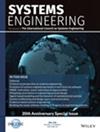开发指标来评估数字工程
IF 1.6
3区 工程技术
Q4 ENGINEERING, INDUSTRIAL
引用次数: 4
摘要
基于模型的系统工程(MBSE)是系统工程(SE)社区日益接受的实践,然而,很少有经验表明MBSE提供价值。此外,随着行业继续向数字化转型,MBSE将成为更大的数字工程(DE)方法的关键组成部分。本文提出了一个测量框架,用于选择和开发适当的指标,以评估MBSE的价值/效益以及随后的DE。利用MBSE文献综述中确定的预期效益,假设了一个因果图,以显示预期效益(潜在指标)如何相互影响和关联。这样做是为了系统地确定哪些好处是最有效的衡量标准。提出了假设的因果模型,以便向开发第一个DE测量框架的工作组的主题专家提供反馈。该组织与工业界、学术界和美国政府共同努力开发DE度量标准。一旦因果图最终确定,案例研究被用来部分验证因果模型。基于因果图和随后的分析,我们可以根据因果模型中最具影响力的节点,推荐用于DE/MBSE的第一批指标。潜在的候选度量包括:系统质量、缺陷、时间、返工、变更的容易程度、系统理解、工作量、信息的可访问性、协作、项目方法/过程,以及DE/MBSE工具的使用。我们相信,整个行业共同努力,专注于测量这些变量,是证明MBSE和DE价值的最有效方法。本文章由计算机程序翻译,如有差异,请以英文原文为准。
Towards Developing Metrics to Evaluate Digital Engineering
Model‐based systems engineering (MBSE) is an increasingly accepted practice in the Systems Engineering (SE) community, however, little has been done to empirically show that MBSE provides value. Furthermore, as the industry continues in the direction of digital transformation, MBSE will become a critical component of the larger Digital Engineering (DE) approach. This paper presents a measurement framework for selecting and developing appropriate metrics to assess the value/benefits of MBSE and subsequently DE. Utilizing expected benefits identified in a review of MBSE literature, a causal map was hypothesized to show how expected benefits (potential metrics) influence and relate to each other. This was done in order to systematically determine which benefits would be the most impactful to measure. The hypothesized causal model was presented for feedback to subject‐matter experts from a working group developing the first DE measurement framework. This group is a joint effort with industry, academia, and the USA government to develop DE metric standards. Once the causal map was finalized, a case study was used to partially validate the causal model. Based on the causal map and subsequent analysis, we can recommend the first metrics to be employed for DE/MBSE based on the most influential nodes of the causal model. The potential metric candidates include: system quality, defects, time, rework, ease of making changes, system understanding, Effort, accessibility of information, collaboration, project methods/processes, and use of DE/MBSE tools. We believe a concerted effort across the industry to focus on measuring these variables is the most effective way to establish proof of the value of MBSE and DE.
求助全文
通过发布文献求助,成功后即可免费获取论文全文。
去求助
来源期刊

Systems Engineering
工程技术-工程:工业
CiteScore
5.10
自引率
20.00%
发文量
0
审稿时长
6 months
期刊介绍:
Systems Engineering is a discipline whose responsibility it is to create and operate technologically enabled systems that satisfy stakeholder needs throughout their life cycle. Systems engineers reduce ambiguity by clearly defining stakeholder needs and customer requirements, they focus creativity by developing a system’s architecture and design and they manage the system’s complexity over time. Considerations taken into account by systems engineers include, among others, quality, cost and schedule, risk and opportunity under uncertainty, manufacturing and realization, performance and safety during operations, training and support, as well as disposal and recycling at the end of life. The journal welcomes original submissions in the field of Systems Engineering as defined above, but also encourages contributions that take an even broader perspective including the design and operation of systems-of-systems, the application of Systems Engineering to enterprises and complex socio-technical systems, the identification, selection and development of systems engineers as well as the evolution of systems and systems-of-systems over their entire lifecycle.
Systems Engineering integrates all the disciplines and specialty groups into a coordinated team effort forming a structured development process that proceeds from concept to realization to operation. Increasingly important topics in Systems Engineering include the role of executable languages and models of systems, the concurrent use of physical and virtual prototyping, as well as the deployment of agile processes. Systems Engineering considers both the business and the technical needs of all stakeholders with the goal of providing a quality product that meets the user needs. Systems Engineering may be applied not only to products and services in the private sector but also to public infrastructures and socio-technical systems whose precise boundaries are often challenging to define.
 求助内容:
求助内容: 应助结果提醒方式:
应助结果提醒方式:


